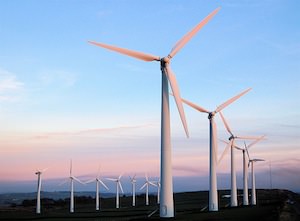Renewable Energy ‘Could Run Australia’
Australia could rely on renewable energy for all its needs, according to new research -- if it could just find the political will to make the change.
By Paul Brown, Climate News NetworkThis piece originally appeared at Climate News Network.
LONDON — Australia could be self-sufficient in renewable energy in 10 years by converting to solar and wind energy if the country had the right social and political leadership, according to the Energy Research Institute of the University of Melbourne.
In a paper published before the current catastrophic heat wave (the Zero Carbon Australia Stationary Energy Plan), the researchers conclude that existing proven technologies could be deployed on a large scale to show an example to the world and to wean Australia off its addiction to fossil fuels.
Australia, the world’s largest coal exporter, has one of the highest per capita emissions of greenhouse gases and has, until recently, resisted tackling climate change.
The report says that if there were the political will Australia’s enormous renewable potential could be harnessed and within a decade both make the country carbon-neutral and create thousands of new jobs.
About 40% of Australian renewables would come from wind farms, but key to the success of the project is the empty landscape and the almost constant solar power of the interior.
Non-stop power production
Solar power would be produced by many buildings, but most power would come from vast towers containing salt water with sunlight directed upon them from fields of mirrors.
The water, heated to more than 500°C, would drive turbines and create 60% of Australia’s electricity. Surplus heat generated during the day would be stored in underground molten salt storage tanks, which would release the heat overnight to enable the turbines to run continuously.
To cover times when the sun did not shine and the wind did not blow there would be back-up plants burning biomass, mostly waste from crop production. Existing reserves of hydropower would be held back to fill any gaps.
Even assuming that electricity demand was 40% higher than today, in 2020 it would still be possible to achieve 100% renewable generation, the report says.
There would need to be large-scale improvements in energy efficiency, particularly to smooth out peaks in demand. But the Institute says this is not impossible. Germany’s per capita electricity use is already 30% less than Australia’s, and its policies are expected to reduce this further over the next 20 years.
The researchers point out that Germany is a modern industrial economy, with a high standard of living, partly based on manufacturing and metal production (including five aluminium smelters), so Australia cannot plead it is a special case.
While the report says that building new electricity production to power homes, offices and factories would come first, Australia would also have to embrace the electric car and train. Again this could be achieved, given the political will.
A total switch to renewable electricity would cost 3% of Australian GDP annually, about A$37 billion (US$39 billion), for 10 years, and an added 6.5 cents per kilowatt hour on the electricity price.
Researchers say wind and solar thermal generators have far lower life-cycle emissions than any other available technology. This is true even of schemes to capture and store carbon from coal plants and of nuclear power, mainly because of the initial fuel mining, processing, transport and handling. Both sorts of plants also take much longer to commission that either solar or wind.
More jobs gained than lost
The report details where these huge solar and wind power generators could be sited around Australia. The plan is for 23 wind farms, each containing turbines able to produce 2,000 to 3,000 megawatts (a typical coal power station produces around 600–700 megawatts, while a unit in a nuclear power plant has an electrical power output of 900–1300 megawatts). They would be dispersed around the country to take advantage of the windiest places and the diversity of weather systems.
There would be 12 sites for concentrated solar power, each containing several towers. Each tower would contain molten salt water and would have 18,000 two-axis tracking mirrors focusing sunlight on the receiver – heating it to at least 565°C.
The towers could be adjusted for the seasons to get the maximum power from the sun. Despite the vast size of the wind and solar farms they would take up less than 0.4% of Australia’s land area.
The plan shows that many more jobs would be created with the construction of a 100% renewable energy grid than those lost with the phasing-out of coal and gas from the existing energy supply chain.
The plan would create 80,000 jobs in the construction phase and 45,000 in operation and maintenance that would continue for the life of the plant. There would be an additional 30,000 jobs in manufacturing if half the plant was made in Australia.
Your support matters…Independent journalism is under threat and overshadowed by heavily funded mainstream media.
You can help level the playing field. Become a member.
Your tax-deductible contribution keeps us digging beneath the headlines to give you thought-provoking, investigative reporting and analysis that unearths what's really happening- without compromise.
Give today to support our courageous, independent journalists.






You need to be a supporter to comment.
There are currently no responses to this article.
Be the first to respond.